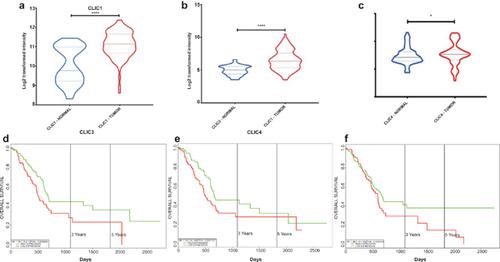当前位置:
X-MOL 学术
›
Curr. Genomics
›
论文详情
Our official English website, www.x-mol.net, welcomes your
feedback! (Note: you will need to create a separate account there.)
In silico transcriptomic analysis of the Chloride Intracellular Channels (CLIC) interactome identifies a molecular panel of seven prognostic markers in patients with pancreatic ductal adenocarcinoma.
Current Genomics ( IF 1.8 ) Pub Date : 2020-05-20 , DOI: 10.2174/1389202921666200316115631 Dimitrios E Magouliotis 1 , Nikos Sakellaridis 1 , Konstantinos Dimas 1 , Vasiliki S Tasiopoulou 1 , Konstantina A Svokos 1 , Alexis A Svokos 1 , Dimitris Zacharoulis 1
Current Genomics ( IF 1.8 ) Pub Date : 2020-05-20 , DOI: 10.2174/1389202921666200316115631 Dimitrios E Magouliotis 1 , Nikos Sakellaridis 1 , Konstantinos Dimas 1 , Vasiliki S Tasiopoulou 1 , Konstantina A Svokos 1 , Alexis A Svokos 1 , Dimitris Zacharoulis 1
Affiliation

|
Background Pancreatic ductal adenocarcinoma (PDAC) is associated with poor prognosis. In this context, the identification of biomarkers regarding the PDAC diagnosis, monitoring, and prognosis is crucial. Objectives The purpose of the current study was to investigate the differential gene expression profile of the chloride intracellular channel (CLIC) gene family network in patients with PDAC, in order to suggest novel biomarkers. Methods In silico techniques were used to construct the interactome of the CLIC gene family, identify the differentially expressed genes (DEGs) in PDAC as compared to healthy controls, and evaluate their potential prognostic role. Results Transcriptomic data of three microarray datasets were included, incorporating 114 tumor and 59 normal pancreatic samples. Twenty DEGs were identified; eight were up-regulated and twelve were downregulated. A molecular signature of seven genes (Chloride Intracellular Channel 1 – CLIC1; Chloride Intracellular Channel 3 – CLIC3; Chloride Intracellular Channel 4 – CLIC4; Ganglioside Induced Differentiation Associated Protein 1 – GDAP1; Ganglioside Induced Differentiation Associated Protein 1 Like 1 – GDAP1L1; Glutathione S-Transferase Pi 1 - GSTP1; Prostaglandin E Synthase 2 – PTGES2) were identified as prognostic markers associated with overall survival. Positive correlations were reported regarding the expression of CLIC1-CLIC3, CLIC4-CLIC5, and CLIC5-CLIC6. Finally, gene set enrichment analysis demonstrated the molecular functions and miRNA families (hsa‐miR‐122, hsa‐miR‐618, hsa‐miR‐425, and hsa‐miR‐518) relevant to the seven prognostic markers. Conclusion These outcomes demonstrate a seven-gene molecular panel that predicts the patients’ prospective survival following pancreatic resection for PDAC.
中文翻译:

氯离子细胞内通道 (CLIC) 相互作用组的计算机转录组学分析确定了胰腺导管腺癌患者的七个预后标志物的分子组。
背景胰腺导管腺癌(PDAC)与预后不良有关。在这种情况下,鉴定有关 PDAC 诊断、监测和预后的生物标志物至关重要。目的 本研究的目的是研究 PDAC 患者氯细胞内通道 (CLIC) 基因家族网络的差异基因表达谱,以提出新的生物标志物。方法 使用计算机技术构建 CLIC 基因家族的相互作用组,与健康对照相比,鉴定 PDAC 中的差异表达基因 (DEG),并评估其潜在的预后作用。结果包括三个微阵列数据集的转录组数据,包括 114 个肿瘤和 59 个正常胰腺样本。确定了 20 个 DEG;8 个被上调,12 个被下调。七个基因的分子特征(氯化物细胞内通道 1 – CLIC1;氯化物细胞内通道 3 – CLIC3;氯化物细胞内通道 4 – CLIC4;神经节苷脂诱导的分化相关蛋白 1 – GDAP1;神经节苷脂诱导的分化相关蛋白 1 Like 1 – GDAP1L1;谷胱甘肽 S -转移酶 Pi 1 - GSTP1;前列腺素 E 合酶 2 - PTGES2)被确定为与总生存期相关的预后标志物。据报道,CLIC1-CLIC3、CLIC4-CLIC5 和 CLIC5-CLIC6 的表达呈正相关。最后,基因集富集分析证明了与七种预后标志物相关的分子功能和 miRNA 家族(hsa-miR-122、hsa-miR-618、hsa-miR-425 和 hsa-miR-518)。
更新日期:2020-05-20
中文翻译:

氯离子细胞内通道 (CLIC) 相互作用组的计算机转录组学分析确定了胰腺导管腺癌患者的七个预后标志物的分子组。
背景胰腺导管腺癌(PDAC)与预后不良有关。在这种情况下,鉴定有关 PDAC 诊断、监测和预后的生物标志物至关重要。目的 本研究的目的是研究 PDAC 患者氯细胞内通道 (CLIC) 基因家族网络的差异基因表达谱,以提出新的生物标志物。方法 使用计算机技术构建 CLIC 基因家族的相互作用组,与健康对照相比,鉴定 PDAC 中的差异表达基因 (DEG),并评估其潜在的预后作用。结果包括三个微阵列数据集的转录组数据,包括 114 个肿瘤和 59 个正常胰腺样本。确定了 20 个 DEG;8 个被上调,12 个被下调。七个基因的分子特征(氯化物细胞内通道 1 – CLIC1;氯化物细胞内通道 3 – CLIC3;氯化物细胞内通道 4 – CLIC4;神经节苷脂诱导的分化相关蛋白 1 – GDAP1;神经节苷脂诱导的分化相关蛋白 1 Like 1 – GDAP1L1;谷胱甘肽 S -转移酶 Pi 1 - GSTP1;前列腺素 E 合酶 2 - PTGES2)被确定为与总生存期相关的预后标志物。据报道,CLIC1-CLIC3、CLIC4-CLIC5 和 CLIC5-CLIC6 的表达呈正相关。最后,基因集富集分析证明了与七种预后标志物相关的分子功能和 miRNA 家族(hsa-miR-122、hsa-miR-618、hsa-miR-425 和 hsa-miR-518)。











































 京公网安备 11010802027423号
京公网安备 11010802027423号